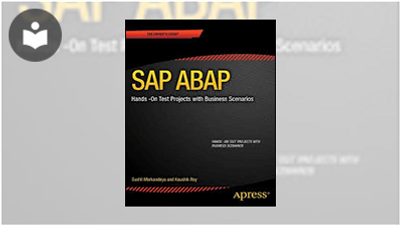SAP ABAP: Hands-On Test Projects with Business Scenarios
- 11h 52m
- Kaushik Roy, Sushil Markandeya
- Apress
- 2014
SAP ABAP (Advanced Business Application Programming) offers a detailed tutorial on the numerous features of the core programming platform, used for development for the entire SAP software suite. SAP ABAP uses hands-on business oriented use cases and a valuable dedicated e-resource to demonstrate the underlying advanced concepts of the OO ABAP environment and the SAP UI. SAP ABAP covers the latest version (NetWeaver 7.3 and SAP application programming release 6.0) of the platform for demonstrating the customization and implementation phases of the SAP software implementation.
Void of theoretical treatments and preoccupation with language syntax, SAP ABAP is a comprehensive, practical one stop solution, which demonstrates and conveys the language’s commands and features through hands on examples.
The presentation of the features is scenario oriented, i.e. most of the features are demonstrated in terms of small business scenarios. The e-resource contains the scenario descriptions, screen shots, detailed screen cams and ABAP program source to enable the reader to create all objects related to the scenario and run/execute them.
The underlying concepts of a feature/command are conveyed through execution of these hands-on programs. Further exercises to be performed independently by the reader are also proposed. The demonstration/illustration objects including the programs rely on some of the SAP application tables being populated, for example an IDES system which is now a de facto system for all SAP training related activities.
What you’ll learn
- The core ABAP platform
- Advanced concepts of OO programming with ABAP
- SAP application tables
- IDES system
- Programming the SAP user interface
Who this book is for
For beginners in SAP application programming, and as a reference for practicing professionals and consultants in SAP ABAP.
About the Authors
Sushil Markandeya is a B.E. from Osmania University (1973) and a M.E. (Electrical Engineering) from B.I.T.S., Pilani (1975). In 1977 he shifted to I.T. He was always involved in business application software on various platforms.
Since 1999, he has been associated with training on ERP software. On SAP, on ABAP; on 'Oracle Applications' on the functional side (financial modules: General Ledger, Fixed Assets Management, Accounts Receivable, Accounts Payable, and Cash Management). Since July 2006, he has been doing corporate training in SAP ABAP for people just out of college. The corporate clients he has trained for are: Accenture India Pvt. Ltd, Wipro Group (Wipro Technologies Ltd., Wipro Infotech. Ltd), Sony India Pvt. Ltd. Mphasis Pvt. Ltd. (part of HP), ITC Infotech Ltd, ITM – Saudi Arabia, Hyundai Motor India Ltd, and Godrej Info Tech. Ltd. To date, he has trained more than 1000 people in these corporations.
Kaushik Roy is involved in requirement definition, design and development of business components, testing, performance tuning and QA related activities. He is a Technical Consultant and is part of a team of highly efficient software professionals. He has solid experience in object oriented analysis and design, UML, user interface design using ABAP, HANA, data modeling and performance tools like HP diagnostics and TPTP. He also has advanced knowledge of the Business Objects tool which is used to develop secured applications.
He has been part of the core team that developed the applications for several clients. He understands the implementation processes very well and has the knowledge to successfully design, develop and implement. He possesses a sound understanding of the end customer's business processes. He has been awarded a Bachelors of Engineering in Computer Science from Uttar Pradesh Technical University in India. He is based out of Detroit, Michigan, USA.
In this Book
-
ERP and SAP Overview
-
ABAP Dictionary/Data Dictionary/DDIC – 1
-
ABAP Dictionary/Data Dictionary/DDIC – 2
-
ABAP Language Basics
-
WRITE Statement (Classical Reporting)
-
Internal Tables
-
Modularization
-
Open SQL Data Retrieval
-
Selection-Screens
-
Interactive Lists
-
ABAP OOP
-
ABAP List Viewer Outputs—Part 1
-
ABAP List Viewer Output—Part 2
-
Screen Programming






